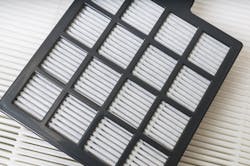“Improvements in ventilation can help reduce risk of transmission of SARS-CoV-2 and other infectious diseases and improve students’ overall health and ability to learn,” says a May report, “School Ventilation: A Vital Tool to Reduce Covid-19 Spread,” from the Johns Hopkins Center for Health Security.
Improving ventilation will not only bolster schools’ ability to ward off the spread of Covid-19, but also provide more healthful learning environments even after the threat of the coronavirus has passed.
“[T]he benefits to investing in healthy air in schools have the potential to outlast the Covid-19 pandemic,” the Johns Hopkins report says. “Improved ventilation may give children and school staff healthier indoor air quality for decades in the future, providing a healthier environment for non-pandemic times and potentially reducing risks in future infectious disease outbreaks.”
Inadequate ventilation
Even before the pandemic that disrupted in-person learning for millions of students, too many education facilities were plagued with inadequate ventilation systems and poor indoor air quality. A nationwide survey of school districts performed by the Government Accountability Office in June 2020 found that 54% of public school districts needed to update or replace multiple building systems or features in their schools.
And even in schools retrofitted with with new HVAC equipment, air quality still may fall short of standards if a system is not installed and maintained properly.
The Johns Hopkins report cited a study that found problems with HVAC equipment, fan control, or filter maintenance in 51% of classrooms studied.
“The problems that were detected highlight the need for better oversight on HVAC system installation and commissioning to ensure adequate classroom ventilation, as well as the need for periodic testing of ventilation systems and ongoing maintenance checks,” the report states.
Those deficiencies in school air quality have far-reaching effects, the report says.
“The EPA has compiled extensive evidence supporting the correlation between indoor air quality and student performance, absenteeism, and even teacher retention,” the report says.
Many facility managers may have balked at addressing ventilation deficiencies because, as the Johns Hopkins report noted, “ventilation improvements may often be perceived as a complicated and expensive investment.”
Federal funding
Concerns over the expense of ventilation upgrades may hold less weight now that the federal government has earmarked billions of dollars in relief funds to help schools and universities recover from the setbacks they experienced during the pandemic and return to full-time in-person instruction.
In 2020 and 2021, Congress appropriated about $190 billion to the Elementary and Secondary School Emergency Relief Fund for K-12 schools. Another $76 billion was earmarked for colleges and universities through the Higher Education Emergency Relief Fund.
The U.S Department of Education is urging education institutions to use some of that funding to improve the air quality in their facilities.
“As we move into the 2021-2022 school year, ventilation continues to be a top concern for many communities,” the Education Department says. “Proper ventilation is a key prevention strategy for maintaining healthy environments and, along with other preventive actions, can reduce the likelihood of spreading disease”
Covid relief funds “can support both immediate actions and longer-term projects, including the inspection, testing, maintenance, repair, replacement, and upgrading of projects to improve indoor air quality in school facilities,” the Education Department says. “This can include system upgrades, filtering, purification and other air cleaning, fans, and window and door repair.”
The Education Department’s guidance specifies many of the ways schools are allowed to use relief funds to improve indoor air quality:
Long-term solutions
The Johns Hopkins report also calls upon the federal government to create a task force to “develop guidance for long-term, sustainable, cost-effective improvements to indoor air quality in schools.”
“The well-documented problems of poor indoor air quality in K-12 schools have been allowed to continue for decades,” the report says. “A path forward is needed to fix these problems.”
The report says the task force should be composed of experts in air quality, industrial hygiene, building science, HVAC systems, epidemiology, engineering, children’s environmental health, and education.
“Together, they should develop guidance for improving, monitoring, and maintaining good indoor air quality,” the report says. “The task force should create standards for school systems to account for different ventilation systems, climates, and conditions around the country.”
About the Author
Mike Kennedy
Senior Editor
Mike Kennedy, senior editor, has written for AS&U on a wide range of educational issues since 1999.


